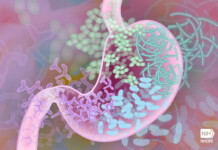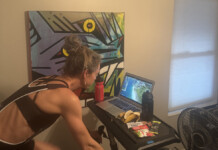By Breanne Nalder, MS and Katherine A. Beals, PhD, RD, FACSM, CSSD — It’s that time of year– the off season; the time when many cyclists reduce the volume of their cycling. With this transition out of high intensity training or racing comes the potential for the dreaded weight gain, especially as the holidays seem designed to make us gain weight. Even the most dedicated cyclists can lose motivation (and willpower) when the weather turns colder, the days grow shorter and the holiday goodies become more plentiful! The following paragraphs will provide suggestions for helping cyclists better manage their training and eating throughout the holiday season and, thus, be ready to ramp up their training in the spring (vs simply trying to undo all the damage they did over the winter months!).
Holiday Weight Gain: Fat or Fiction?
When it comes to holiday weight gain there is both good news and bad news. The good news is that most of us gain less weight over the holidays than originally thought. In fact, research suggests that the average weight gain is only about 1 pound, not the oft-cited 7-10 lbs. The bad news is that holiday weight gained is rarely lost. Thus, that seemingly small amount of weight gained over a given holiday season can add up over the years.
So, how do we keep our bodies in check and be ready to train for next year while still enjoying the off season? Well, you can start by being realistic. The holiday season is not an ideal time to lose weight. In fact, it is probably self-defeating to try. Instead, the best strategy is to try to maintain your current weight during the holidays and focus on any weight loss goals around the New Year. It may be helpful to devise a holiday eating plan that includes strategies for handling nutritionally precarious situations. Some tried and true strategies include the following:
- Take preventative measures: If you tend to overeat at parties, try eating a low-calorie snack to help curb your appetite before leaving the house. Chances are if you arrive at the party ravenous, you will overeat.
- Don’t vow to eat nothing at a special event: In doing so, you will just be setting yourself up for failure and subsequent guilt. Instead, limit your selections to foods you don’t typically eat and keep your portion sizes under control.
- When it comes to seconds, use the 20- minute rule: It typically takes 20 minutes after you have eaten for your satiety center to kick in and register that you are full. Thus, before going back for a second helping, wait 20 minutes. If you still feel hungry, go for seconds but keep your portion sizes small and go easy on the high-fat, high-calorie foods.
- Share the wealth: If you host a party or dinner, have disposable containers available for guests to take home leftovers. This will help get tempting foods out of your house entirely!
- Bring the healthy dish: When contributing to the party, take something low in calories and high in nutrition, such as raw vegetables and hummus, fresh fruit, or a less guilty desert (see the “Crave That? Eat This!” list of healthy alternatives).
- Go easy on the alcohol: Most people are well aware of the added poundage that can be brought on by mashed potatoes and gravy or pecan pie. Don’t underestimate that alcohol itself is chock-full of calories (kcals). For example, a typical two ounces of alcohol (such as might be found in a typical mixed drink) contains approximately 141 kcals, and that’s not including the mixer, which can easily add another 100-300 kcals! An eight-ounce glass of eggnog with rum contains 400 kcals. Beer and wine may be smarter options, with 150 kcals for a typical serving (i.e., 12 and eight ounces, respectively). And research suggests that those additional alcohol calories are stored as fat instead of used for energy. In addition, alcohol tends to distort our nutritional judgment, causing us to consume more high-calorie, high-fat foods than we would if we were not under the influence.
- Exercise! While it is a good idea to balance your energy intake with the appropriate amount of exercise on a regular basis, it is particularly important during the off season. Unfortunately, many cyclists use the excuse of a “hectic holiday schedule” to sideline their exercise program. Colder temperatures and shorter days can also make cycling (outside) uncomfortable and even unsafe. Rather than ditch the training programs altogether, cyclists should explore the multitude of winter sports in Utah, preferably those that compliment or enhance their cycling such as Nordic and/or alpine skiing, ice-skating and snowshoeing. This would also be a good time to get back into the weight room and work on your strength and power (not to mention your bone health!). And, of course, there are numerous indoor cycling options ranging from group spin classes to stationary bikes and trainers that you can purchase for your own personal use at home.
Crave That? Eat This!
No one can deny that food is a big part of the holidays, but it is not the only part, and certainly is not the most important. So, when it comes to food, forget the all or nothing mindset. Depriving yourself of holiday treats or feeling guilty after eating isn’t part of a healthy eating strategy. Here is a list of some foods, snacks, and dishes (all with less than 150 calories) that will help you keep yourself healthy and satisfied during the winter so you’re proud of your body and fit for next season!
- Morning Perk: Enjoy an 8-ounce skim or soy milk latte or spiced chai
- Breakfast Boost: Mix non-fat vanilla yogurt with 1/2 a cup of blueberries and raspberries
- “Ants on a Log”: Fill 5 ribs of celery with one tablespoon of peanut butter
- Caprese: Top low-fat mozzarella cheese with tomatoes and fresh basil leaves and drizzle with olive oil and balsamic vinegar
- Protein-Packed snack: Wrap 2 ounces of low-sodium turkey (or tofurkey or tuna) with 1 Tbsp hummus in a collard leaf
- Pumpkin pudding: 1/2 cup pumpkin puree with 1/2 cup yogurt and cinnamon
- Sweet and Savory: 2 oz of low-fat cottage cheese with one medium peach or sliced tomatoes
- Midday Munchies: Top half a medium apple with a 1-ounce slice of low-fat cheese
- Movie Night Necessity: Spray a tablespoon of olive oil and sprinkle sea salt over 2 cups of air-popped popcorn (no butter of course!)
Salty Sensations
- Pop Chips! 1 serving
- 1 small bag soy crisps or baked chips (potato, tortilla, vegetable)
- 1 oz pretzels
- 1 cup edamame
- 1/4 cup plain or flavored almonds or ½ cup pistachios in the shell
- 2 Laughing Cow Light cheese wedges spread on 2 Wasa Crisp’n Light crackers
- Half a baked potato topped with salsa
- Half a medium avocado, drizzled with fresh lime juice and lightly sprinkled with salt
- 5 mini chocolate rice cakes, each covered with a thin spread of natural peanut butter
Sweet Tooth Satisfiers
- 1 frozen fruit pop or Italian ice
- 1 sliced frozen banana
- 1 cup berries, grapes, fruit salad or watermelon
- 2 small cookies (such as Newman-O’s), 1 biscotti, or 8 vanilla wafers
- 1/2 sweet potato w/cinnamon 1tsp brown sugar
- Microwaved apple sprinkled with cinnamon and/or nutmeg
- 1 oz dark chocolate (like 3 Dove Promises mini dark chocolates)
- 1/4 cup Chocolate chips (yummy to keep frozen)
- Brew a cup of chamomile tea before bed (maybe add a tsp of honey) good night!
Breanne Nalder, MS recently completed here master’s degree in nutrition with an emphasis in sports dietetics at the University of Utah and is a competitive CAT 1,2,3 cyclist.
Katherine Beals, PhD, RD, FACSM, CSSD is an associate professor (clinical) in the Division of Nutrition at the University of Utah. She is a registered dietitian, a certified specialist in sports dietetics and a fellow of the American College of Sports Medicine.





